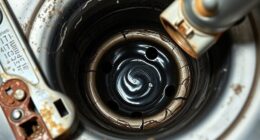Indoor ozone generators can effectively reduce odors, bacteria, and mold by reacting with airborne contaminants, often providing noticeable air freshness. However, they pose health risks such as respiratory irritation and may produce secondary pollutants, especially if used improperly. While they can reach hidden sources more thoroughly than some filters, long-term exposure and environmental concerns exist. To make a safe choice, it’s important to understand both the benefits and potential hazards—more details can guide you toward responsible use.
Key Takeaways
- Ozone generators effectively remove odors, bacteria, and mold by chemically reacting with airborne contaminants for quick air quality improvement.
- They pose health risks such as respiratory irritation and long-term lung issues if used improperly or without proper ventilation.
- Unlike filters, ozone reacts with pollutants directly but can create secondary pollutants like formaldehyde, impacting indoor air safety.
- Environmental concerns include contribution to outdoor smog and damage to ecosystems if ozone is released in excess or misused indoors.
- Responsible use involves operating only when spaces are unoccupied, ensuring thorough ventilation, and following safety guidelines to mitigate health and environmental risks.
How Ozone Generators Improve Indoor Air Quality
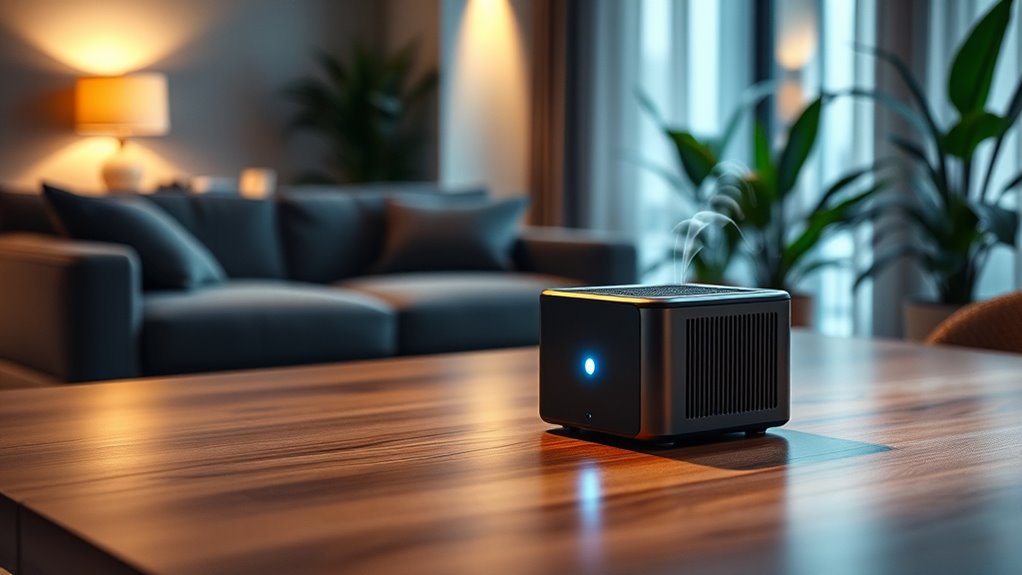
Ozone generators can substantially enhance indoor air quality by actively reducing odors, bacteria, and mold spores. They work by releasing ozone molecules into the air, which react with and break down airborne contaminants. This process helps eliminate persistent smells from pets, smoke, or cooking, making your indoor environment fresher. Additionally, ozone’s strong oxidative properties target bacteria and mold spores, reducing their presence and potential health risks. Unlike passive air cleaners, ozone generators actively treat the air in real-time, providing a noticeable improvement in overall cleanliness. Proper operation guarantees that your indoor air becomes healthier, cleaner, and more comfortable for you and your family. As technology advances, automation in air purification offers new ways to optimize indoor environments safely.
Odor Removal Capabilities of Ozone Devices
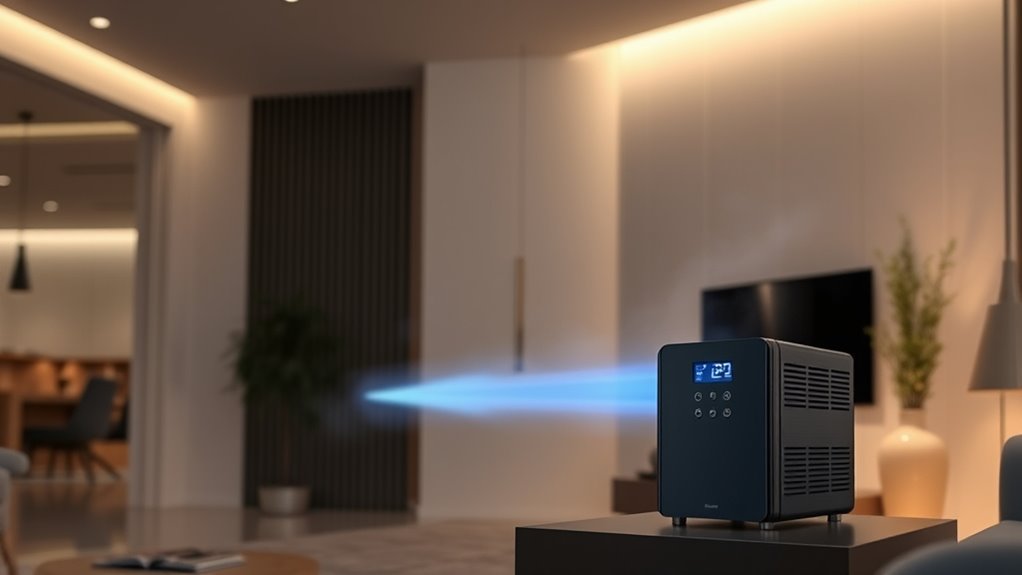
Have persistent odors from pets, smoke, or cooking become a challenge to your indoor environment? Ozone generators are often used to combat these smells because they produce ozone, a powerful oxidizer. When ozone interacts with odor molecules, it breaks them down into simpler, less noticeable compounds, effectively neutralizing the smell. This process can be quick and efficient, especially for stubborn odors that linger after cleaning or ventilation. However, ozone doesn’t just target odors; it also reacts with other airborne particles, helping to improve overall air freshness. Keep in mind, ozone’s strong oxidative properties mean it can eliminate odors more completely than some air fresheners or filters. Proper ozone concentration levels are essential to ensure safety and effectiveness during odor removal. If used correctly, ozone devices can be an effective tool for odor removal, especially in unoccupied rooms.
Potential Health Risks Associated With Ozone Exposure

Exposure to ozone can cause immediate respiratory irritation, leading to coughing and shortness of breath. Over time, repeated exposure may contribute to more serious health issues, especially for those with pre-existing conditions. It’s important to understand these risks before using ozone-generating devices indoors. Additionally, somatic therapy techniques have been shown to help individuals manage stress and respiratory issues related to environmental exposures.
Respiratory Irritation Risks
Breathing in ozone produced by indoor generators can pose significant health risks, especially to your respiratory system. Ozone irritates your airways, leading to coughing, throat discomfort, and shortness of breath. If you already have asthma or allergies, these effects can worsen. Prolonged exposure may cause inflammation and reduce lung function. Children and the elderly are particularly vulnerable. To better understand the risks, consider these points:
- Ozone irritates nasal passages and lungs
- Causes coughing and throat irritation
- Exacerbates asthma and allergy symptoms
- Leads to inflammation with repeated exposure
- Understanding industry trends aids in job acquisition and safety measures helps in making informed decisions about ozone generator use indoors.
Being aware of these effects helps you decide whether using an ozone generator indoors is worth the potential health trade-offs.
Long-Term Health Effects
While short-term respiratory irritation is an immediate concern, prolonged inhalation of ozone can also lead to serious long-term health problems. Chronic exposure may cause persistent lung inflammation, reducing your lung function over time. It can worsen conditions like asthma, making breathing more difficult and increasing your susceptibility to respiratory infections. Long-term ozone exposure may also contribute to the development of lung diseases such as COPD. Additionally, ozone can damage your respiratory tissues, leading to scarring and decreased lung elasticity. This ongoing harm not only affects your breathing but can also impact your overall health, increasing your risk for cardiovascular issues. Following environmental considerations and reducing exposure and avoiding ozone generators indoors is essential to protect your long-term respiratory health.
Safety Precautions When Using Ozone Generators
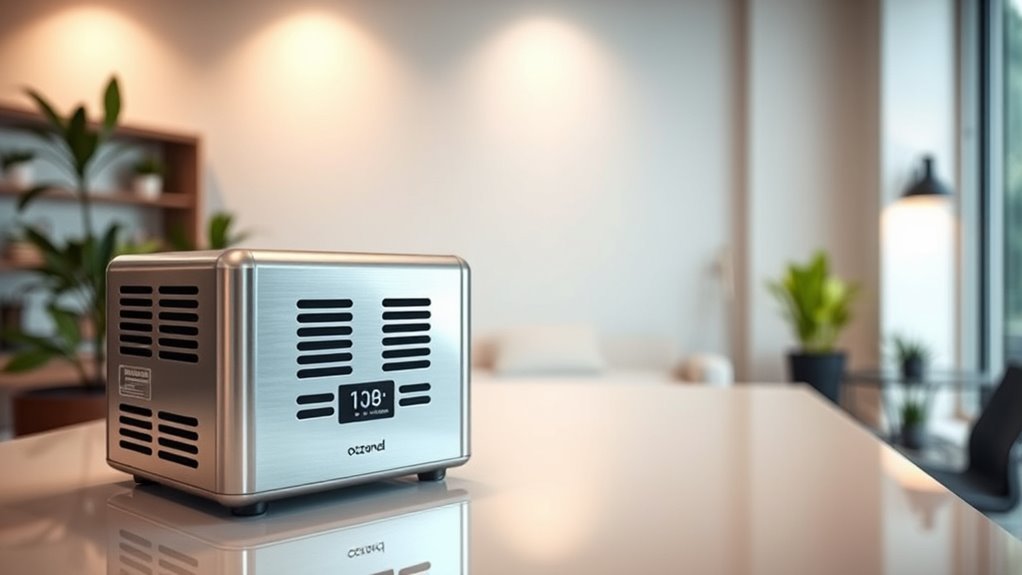
Using ozone generators safely is essential to prevent health risks and guarantee effective operation. Always operate the device when no people, pets, or plants are present. Ventilate the area thoroughly after use before re-entering. Follow the manufacturer’s instructions carefully, including recommended exposure times. Use ozone generators in unoccupied spaces and avoid prolonged exposure to high ozone levels. Regularly inspect the device for damage or malfunctions. Store the generator in a secure, dry place away from children and pets. Keep windows and doors closed during operation to contain ozone. After use, allow sufficient time for ozone to dissipate before re-entering. Proper exposure management is crucial for safe and effective ozone use.
Differences Between Ozone and Other Air Purification Methods
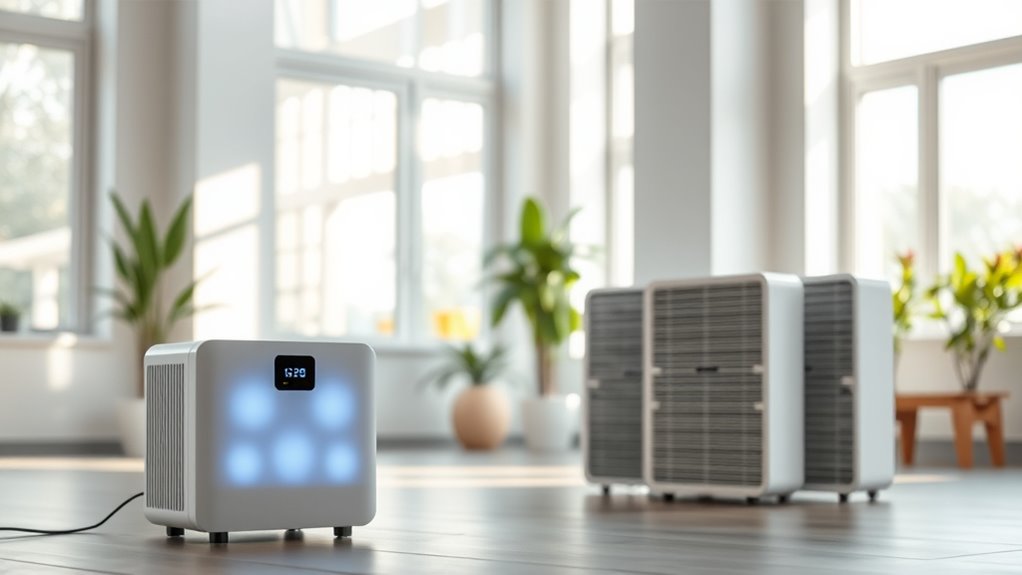
Ozone generators differ from other air purification methods primarily in how they eliminate contaminants. Unlike HEPA filters that trap particles like dust, pollen, and pet dander, ozone generators produce ozone molecules that react with airborne pollutants. This chemical reaction breaks down odors, bacteria, and viruses, effectively neutralizing them. While HEPA filters physically capture particles, ozone works chemically, which can reach hidden or odor-causing sources more thoroughly. However, this process also means ozone can pose health risks if not used correctly, unlike filters that don’t produce harmful byproducts. Additionally, UV purifiers use ultraviolet light to kill microorganisms, and activated carbon filters absorb gases and odors, but neither produces ozone. Understanding these differences helps you choose the right method for your indoor air quality needs. Ozone production is a key factor to consider when evaluating air purification options.
Regulations and Standards for Ozone Generator Use
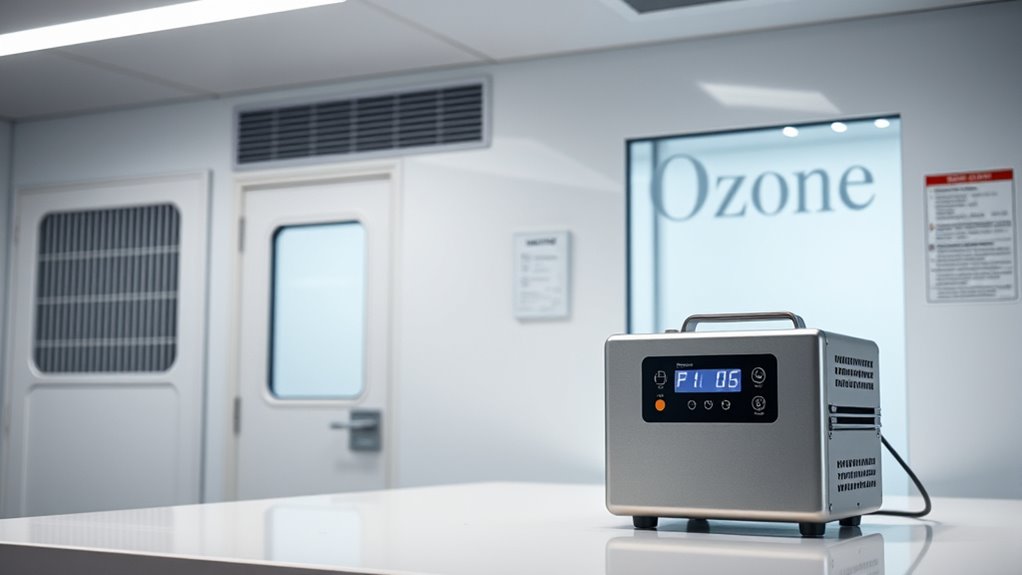
Regulations and standards for ozone generator use are vital to guarantee safety and effectiveness. They set guidelines on safe ozone levels, proper device operation, and permissible applications. These rules help prevent health risks from overexposure and ensure devices work as intended. Compliance with regulations often involves certification processes and adherence to manufacturer instructions. In many regions, agencies like the EPA or FDA oversee ozone device standards, emphasizing indoor air quality and public health. Knowing the regulations helps you choose compliant products and avoid unsafe practices. It’s essential to stay informed about local laws and manufacturer recommendations. Proper regulation ensures that ozone generators are used responsibly, minimizing health hazards and maximizing their intended benefits. Regular use of ozone in accordance with exposure limits reduces potential health risks. Always verify that your device meets relevant standards before use.
Long-term Effects and Environmental Impact
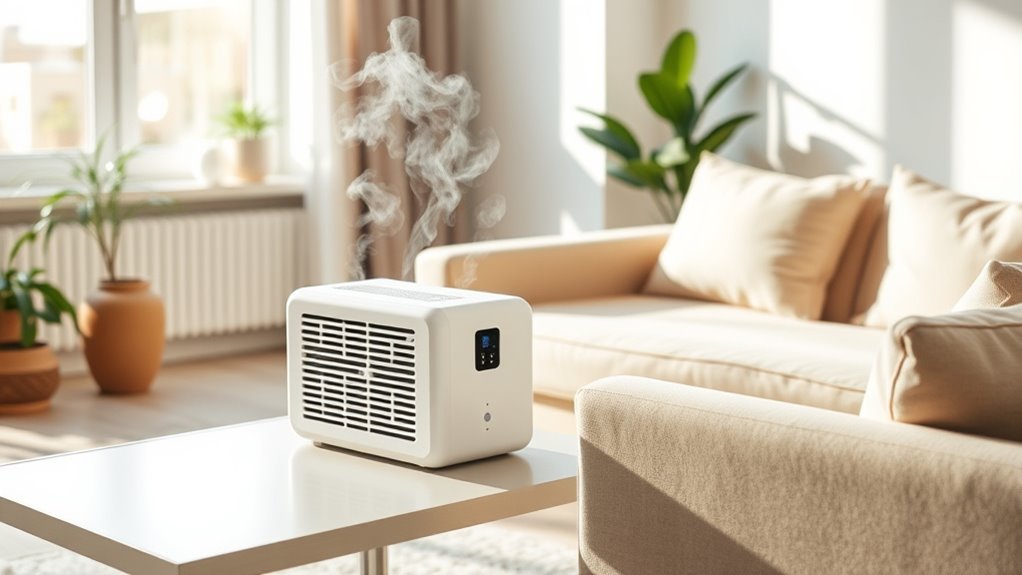
While regulations help guarantee safe use of ozone generators, understanding their long-term effects and environmental impact is equally important. Over time, ozone can react with indoor surfaces, creating secondary pollutants like formaldehyde and other volatile organic compounds (VOCs). These substances can linger in your home, potentially affecting your health and that of your family. Additionally, ozone contributes to outdoor smog formation when released in large quantities, impacting air quality on a broader scale. Continuous exposure to ozone can irritate your respiratory system, especially in sensitive individuals. Environmentally, excessive ozone generation can harm plants, degrade materials, and contribute to ground-level ozone pollution. Being aware of these effects helps you make informed decisions about using ozone generators responsibly and minimizing potential long-term harm. Moreover, Vetted – Grobal World emphasizes the importance of understanding how ozone interacts with various materials and ecosystems in the long run.
Making an Informed Decision: Is an Ozone Generator Right for You?

Deciding whether an ozone generator is right for your home requires careful consideration of both its benefits and potential risks. While it can help eliminate odors and certain pollutants, it also produces ozone that can harm your health. You should evaluate your specific needs, such as allergy relief or odor removal, against the possible respiratory issues caused by ozone exposure. Consider whether you’re willing to manage the safety precautions necessary when using ozone generators. If you have respiratory conditions or young children, these devices might not be suitable. To help decide, think about:
- The primary indoor air quality concern
- Your ability to follow safety guidelines
- Alternatives like ventilation or air purifiers
- The potential health risks involved
Frequently Asked Questions
Are There Specific Room Sizes Best Suited for Ozone Generator Use?
When considering room sizes for ozone generators, you should match the device’s capacity to the space. Smaller rooms, like bedrooms or closets, require lower ozone output, while larger areas, such as living rooms or garages, need higher capacity units. Always check the manufacturer’s recommendations to make certain of safe and effective use. Remember, overusing ozone in a small space can be harmful, so choose a generator suited to your room size.
How Often Should Ozone Generators Be Operated for Optimal Results?
You should operate your ozone generator only as needed, generally for short periods like 2-4 hours, to effectively treat odors or air quality issues. Avoid leaving it on continuously, as overuse can cause health risks and ozone buildup. Always follow manufacturer guidelines, and after use, ventilate the space thoroughly. Regularly monitor the environment, and limit exposure to guarantee safety and ideal results.
Can Ozone Generators Be Used Safely Around Pets and Children?
You might think ozone generators are safe around pets and children, but research shows they can pose health risks. Ozone can irritate lungs, worsen asthma, and harm sensitive individuals. Even small amounts can be dangerous in enclosed spaces. To protect your loved ones, avoid using ozone generators where pets and children are present, or use them only when no one is in the room and follow strict safety guidelines.
What Are the Signs of Overexposure to Ozone Indoors?
If you’re concerned about ozone exposure indoors, watch for signs like coughing, throat irritation, chest pain, or shortness of breath. You might also notice eye irritation or a lingering smell of ozone. If you experience these symptoms, it’s a sign you should increase ventilation and reduce ozone levels immediately. Always prioritize safety by limiting exposure, especially around children and pets, to prevent health issues related to overexposure.
Are There Alternative Air Cleaning Methods That Don’T Produce Ozone?
Breathe better by choosing safer solutions. Instead of ozone generators, you can use HEPA filters, which trap tiny particles, or activated charcoal filters that absorb odors and chemicals. Ventilation helps circulate fresh air, reducing pollutants naturally. UV light air purifiers kill germs without producing ozone. These alternatives are safer, more effective, and avoid the health hazards associated with ozone, making your indoor environment healthier and happier.
Conclusion
Think of choosing an ozone generator like steering a vast ocean—powerful and effective, but with hidden currents to beware of. You hold the compass; understanding its pros and cons guides your voyage toward cleaner air. With careful precautions and informed choices, you can harness its potential like a skilled sailor, steering clear of storms. Ultimately, your decision shapes whether your indoor environment becomes a safe harbor or a treacherous sea.






